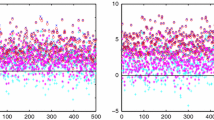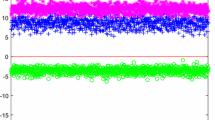Abstract
In this paper, we have proposed some new upper bounds for the largest Z-eigenvalue of an irreducible weakly symmetric and nonnegative tensor, which improve the known upper bounds obtained in Chang et al. (Linear Algebra Appl 438:4166–4182, 2013), Song and Qi (SIAM J Matrix Anal Appl 34:1581–1595, 2013), He and Huang (Appl Math Lett 38:110–114, 2014), Li et al. (J Comput Anal Appl 483:182–199, 2015), He (J Comput Anal Appl 20:1290–1301, 2016).
Similar content being viewed by others
Background
Let \({\mathbb{R}}\) be the real field. An mth order n dimensional square tensor \(\mathcal {A}\) consists of \(n^m\) entries in \({\mathbb{R}}\), which is defined as follows:
\(\mathcal {A}\) is called nonnegative if \(a_{i_1 i_2 \ldots i_m } \ge 0\). To an n-vector x, real or complex, we define the n-vector:
and
If \(\mathcal {A}x^{m-1}=\lambda x^{[m-1]}\), x and \(\lambda\) are all real, then \(\lambda\) is called an H-eigenvalue of \(\mathcal {A}\) and x an H-eigenvector of \(\mathcal {A}\) associated with \(\lambda\). If \(\mathcal {A}x^{m-1}=\lambda x\) with \(x^Tx=1\), x and \(\lambda\) are all real, then \(\lambda\) is called a Z-eigenvalue of \(\mathcal {A}\) and x a Z-eigenvector of \(\mathcal {A}\) associated with \(\lambda\) Qi (2005), Lim (2005). See more about the eigenvalue problems of tensors in Chang et al. (2009, 2010), Qi (2007), Yang and Yang (2010, 2011), Ng et al. (2009), Zhou et al. (2013), Li et al. (2014, 2015), Hu and Huang (2012), Hu et al. (2013).
The following definition for irreducibility has been introduced in Chang et al. (2008) and Lim (2005).
Definition 1
The square tensor \(\mathcal {A}\) is called reducible if there exists a nonempty proper index subset \({\mathbb{J}} \subset \{ 1,2,\ldots ,n \}\) such that \(a_{i_1,i_2,\ldots ,i_m} = 0,\ \ \forall i_1 \in {\mathbb{J}},\ \ \forall i_2, \ldots , i_m \notin {\mathbb{J}}.\) If \(\mathcal {A}\) is not reducible, then we call \(\mathcal {A}\) to be irreducible.
Definition 2
Let \(\mathcal {A}\) be an m-order and n-dimensional tensor. We define \(\sigma (\mathcal {A})\) the Z-spectrum of \(\mathcal {A}\) by the set of all Z-eigenvalues of \(\mathcal {A}\). Assume \(\sigma (\mathcal {A})\ne \emptyset\), then the Z-spectral radius of \(\mathcal {A}\) is denoted by
Let \(N=\{1,2, \ldots ,n\}\). In 2013, Chang et al. gave the following bound for the Z-eigenvalues of an m-order n-dimensional tensor \(\mathcal {A}\).
Theorem 1
Let \(\mathcal {A}\) be an m-order and n-dimensional tensor. Then
For the positively homogeneous operators, Song and Qi (2013) studied the relationship between the Gelfand formula and the spectral radius as well as the upper bound of the spectral radius. From Corollary 4.5 in Song and Qi (2013), we can get the following result:
Theorem 2
Let \(\mathcal {A}\) be an m-order and n-dimensional tensor. Then
We shall denote the set of all mth order n dimensional tensors by \({\mathbb{R}}^{[m,n]}\), and the set of all nonnegative (or, respectively, positive) mth order n dimensional tensors by \({\mathbb{R}}_+^{[m,n]}\) (or, respectively, \({\mathbb{R}}_{++}^{[m,n]}\)). If the tensor is positive, He and Huang gave the following Z-eigenpair bound (see Theorem 2.7 of He and Huang 2014):
Theorem 3
Suppose that \(\mathcal {A}=(a_{i_1i_2 \ldots i_m}) \in {\mathbb{R}}_{++}^{[m,n]}\) is an irreducible weakly symmetric tensor. Then
where \(R_i = \sum\nolimits _{i_2 , \ldots ,i_m = 1}^n {|a_{ii_2 \ldots i_m } |}\),
Li et al. obtained the following upper bound (see Theorem 3.5 of Li et al. 2015):
Theorem 4
Suppose that \(\mathcal {A}=(a_{i_1i_2 \ldots i_m}) \in {\mathbb{R}}_+^{[m,n]}\) is an irreducible weakly symmetric tensor. Then
where
A real tensor of order m dimension n is called the unit tensor, if its entries are \(\delta _{i_1\ldots i_m}\) for \(i_1,\ldots ,i_m\in N\), where
And we define
He gave the following upper bound (see Theorem 3.3 of He 2016):
Theorem 5
Suppose that \(\mathcal {A}=(a_{i_1i_2 \ldots i_m}) \in {\mathbb{R}}_+^{[m,n]}\) is an irreducible weakly symmetric tensor. Then
where
Our goal in this paper is to show some tighter upper bounds for the largest Z-eigenvalue of a nonnegative tensor. In section “Main results”, some new upper bounds for the largest Z-eigenvalue are obtained, which are tighter than the results in Theorems 1–5 (Chang et al. 2013; Song and Qi 2013; He and Huang 2014; Li et al. 2015; He 2016).
Main results
In this section, we consider some new upper bounds for the largest Z-eigenvalue of a nonnegative tensor.
A tensor \(\mathcal {A}\) is called weakly symmetric if the associated homogeneous polynomial \(\mathcal {A}x^m\) satisfies
This concept was first introduced and used by Chang et al. (2013) for studying the properties of Z-eigenvalue of nonnegative tensors and presented the following Perron-Frobenius Theorem for the Z-eigenvalue of nonnegative tensors.
Lemma 1
Suppose that \(\mathcal {A}=(a_{i_1i_2 \ldots i_m}) \in {\mathbb{R}}_+^{[m,n]}\) is an irreducible weakly symmetric tensor, then the spectral radius \(\rho (\mathcal {A})\) is a positive Z-eigenvalue with a positive Z-eigenvector.
Based on the lemma, we give our main results as follows.
Theorem 6
Suppose that \(\mathcal {A}=(a_{i_1i_2 \ldots i_m}) \in {\mathbb{R}}_+^{[m,n]}\) is an irreducible weakly symmetric tensor. Then
where
Proof
First, Let \(x=(x_1,\ldots ,x_n)^T\) be an Z-eigenvector of \(\mathcal {A}\) corresponding to \(\rho (\mathcal {A})\), that is,
Assume \(0< x_t=\mathop {\max }\nolimits _{i \in N} x_i\), then, for any \(s\ne t\), by using \(x_t^{m-1}\le x_t\), \(x_s^{m-1}\le x_s\), we get
From Corollary 4.10 in Chang et al. (2013), we have
Then, from (7) and (8), we obtain, we obtain
Recalling that \(0< x_t=\mathop {\max}\nolimits _{i \in N} x_i\), we have
Therefore
This must be true for every \(s\ne t\), then, we get
And this could be true for any \(t \in N\), that is
Thus, we complete the proof. \(\square\)
Remark 1
Obviously, we can get
That is to say, the bound in Theorem 6 is always better than the result in Theorem 5.
We denote
And let
Then, \(r_i(\mathcal {A})=r_i^{\Delta _j }+r_i^{{\overline{\Delta }} _j } (\mathcal {A})\).
Theorem 7
Suppose that \(\mathcal {A}=(a_{i_1i_2 \ldots i_m}) \in {\mathbb{R}}_+^{[m,n]}\) is an irreducible weakly symmetric tensor. Then
where
Proof
First, Let \(x=(x_1,\ldots ,x_n)^T\) be an Z-eigenvector of \(\mathcal {A}\) corresponding to \(\rho (\mathcal {A})\), that is,
Assume \(0< x_t=\mathop {\max }\nolimits _{i \in N} x_i\), then, we can get
That is
Similarly, we can get
From Corollary 4.10 in Chang et al. (2013), we have
Then, from (13) and (14), we obtain, we obtain
Recalling that \(0< x_t=\mathop {\max }\nolimits _{i \in N} x_i\), we have
Therefore
This must be true for every \(s\ne t\), then, we get
And this could be true for any \(t \in N\), that is
Thus, we complete the proof. \(\square\)
Remark 2
Let \(\Pi _i\) be a nonempty proper subset of \(\Delta _i\), we have that for \((i_2, \ldots , i_m) \in \Pi _i\),
Similar to the proof of Theorem 7, we can get
where
which is always better than the result in Theorem 6.
Example 1
We now show the efficiency of the new upper bounds in Theorems 6 and 7 by the following example. Consider the tensor \(\mathcal {A}=(a_{ijk})\) and of order 3 dimension 3 with entries defined as follows:
By Theorem 1, we have
By Theorem 2, we have
By Theorem 3, we have
By Theorem 4, we have
By Theorem 5, we have
By Theorem 6, we have
By Theorem 7, we have
This example shows that the bound in Theorem 7 is the best among the known bounds.
References
Chang KC, Pearson K, Zhang T (2009) On eigenvalue problems of real symmetric tensors. J Math Anal Appl 350:416–422
Chang KC, Pearson K, Zhang T (2013) Some variational principles for Z-eigenvalues of nonnegative tensors. Linear Algebra Appl 438:4166–4182
Chang KC, Qi L, Zhou G (2010) Singular values of a real rectangular tensor. J Math Anal Appl 37:284–294
Chang KC, Zhang T, Pearson K (2008) Perron–Frobenius theorem for nonnegative tensors. Commun Math Sci 6:507–520
He J (2016) Bounds for the largest eigenvalue of nonnegative tensors. J Comput Anal Appl 20:1290–1301
He J, Huang TZ (2014) Upper bound for the largest z-eigenvalue of positive tensors. Appl Math Lett 38:110–114
Hu S, Huang Z (2012) Theorems of the alternative for inequality systems of real polynomials. J. Optim. Theory Appl 154:1–16
Hu S, Huang Z, Qi L (2013) Finding the extreme z-eigenvalues of tensors via a sequential semidefinite programming method. Numer Linear Algebra Appl 20:972–984
Li C, Chen Z, Li Y (2015) A new eigenvalue inclusion set for tensors and its applications. Linear Algebra Appl 481:36–53
Li C, Li Y, Kong X (2014) New eigenvalue inclusion sets for tensors. Numer Linear Algebra Appl 21:39–50
Li W, Liu D, Vong S (2015) Z-eigenpair bounds for an irreducible nonnegative tensor. J Comput Anal Appl 483:182–199
Lim LH (2005) Singular values and eigenvalues of tensors: A variational approach. In: Proceedings of the IEEE international workshop on computational advances in multi-sensor adaptive processing, pp 129–132. CAMSAP 05
Ng MK, Qi L, Zhou G (2009) Finding the largest eigenvalue of a non-negative tensor. SIAM J Matrix Anal Appl 31:1090–1099
Qi L (2005) Eigenvalues of a real supersymmetric tensor. J Symb Comput 40:1302–1324
Qi L (2007) Eigenvalues and invariants of tensor. J Math Anal Appl 325:1363–1377
Song Y, Qi L (2013) Spectral properties of positively homogeneous operators induced by higher order tensors. SIAM J Matrix Anal Appl 34:1581–1595
Yang Y, Yang Q (2010) Further results for Perron–Frobenius theorem for nonnegative tensors. SIAM J Matrix Anal Appl 31:2517–2530
Yang Y, Yang Q (2011) Further results for Perron–Frobenius theorem for nonnegative tensors II. SIAM J Matrix Anal Appl 32:1236–1250
Zhou G, Caccetta L, Qi L (2013) Convergence of an algorithm for the largest singular value of a nonnegative rectangular tensor. Linear Algebra Appl 438:959–968
Authors' contributions
All authors contributed equally to this work. All authors read and approved the final manuscript.
Acknowledgements
This work was supported by the Doctoral Scientific Research Foundation of Zunyi Normal College (No. BS[2015]09); Science and technology Foundation of Guizhou province (Qian ke he Ji Chu [2016]1161). Liu is supported by National Natural Science Foundations of China (Grants nos. 71461027); Science and technology talent training object of Guizhou province outstanding youth (Qian ke he ren zi [2015]06); Guizhou province natural science foundation in China (Qian Jiao He KY [2014]295); 2013, 2014 and 2015 Zunyi 15851 talents elite project funding; Zhunyi innovative talent team(Zunyi KH(2015)38). Tian is supported by the Science and Technology fund Project of GZ (Qian ke he J Zi [2015]2147, Qian jiao he KY[2015]451). Ke is supported by the Science and Technology fund Project of GZ (Qian Ke He J Zi LKZS [2012]08). Li is supported by the Science and Technology fund Project of GZ (Qian Ke He LH[2015]7047).
Competing interests
The authors declare that they have no competing interests.
Author information
Authors and Affiliations
Corresponding author
Additional information
Jun He, Yan-Min Liu, Hua Ke, Jun-Kang Tian and Xiang Li contributed equally to this work
Rights and permissions
Open Access This article is distributed under the terms of the Creative Commons Attribution 4.0 International License (http://creativecommons.org/licenses/by/4.0/), which permits unrestricted use, distribution, and reproduction in any medium, provided you give appropriate credit to the original author(s) and the source, provide a link to the Creative Commons license, and indicate if changes were made.
About this article
Cite this article
He, J., Liu, YM., Ke, H. et al. Bounds for the Z-spectral radius of nonnegative tensors. SpringerPlus 5, 1727 (2016). https://doi.org/10.1186/s40064-016-3338-3
Received:
Accepted:
Published:
DOI: https://doi.org/10.1186/s40064-016-3338-3




